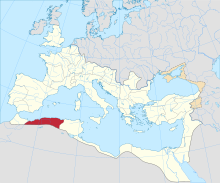Mauretania Caesariensis
| Provincia Mauretania Caesariensis | |||||||||
|---|---|---|---|---|---|---|---|---|---|
| Province of the Roman Empire | |||||||||
| 42 AD–7th century | |||||||||
 The province of Mauretania Caesariensis within the Roman Empire, c. AD 125 | |||||||||
| Capital | Caesarea | ||||||||
| Historical era | Classical antiquity | ||||||||
• Africa reorganized | 42 AD | ||||||||
| 7th century | |||||||||
| |||||||||
| Today part of | |||||||||
Mauretania or Mauritania Caesariensis (Latin for "Caesarian" or "Cherchelli Mauretania") was a Roman province located in what is now Algeria in the Maghreb, with its capital at Caesarea (modern Cherchell). The name of the capital was used to distinguish it from neighboring Mauretania Tingitana, which was ruled from Tangiers.
Historical background

In the 1st century AD, Roman emperor Claudius divided the westernmost Roman province in Africa, named Mauretania (land of the Mauri people, hence the word Moors), into Mauretania Caesariensis (named after its capital, one of many cities simply named Caesarea after the imperial cognomen that had become a title) and Mauretania Tingitana.
Under Diocletian's Tetrarchy reform, the easternmost part was broken off from Mauretania Caesariensis as a separate small province, Mauretania Sitifensis, called after its inland capital Sitifis (actual Sétif) with a significant port at Saldae (presently Béjaïa).
Mauretania Caesariensis contained eight colonies founded by Augustus, Cartennas, Gunugu, Igilgili, Rusguniae, Rusazu, Saldae, Zuccabar, Tubusuctu; two by Claudius, Caesarea formerly "Iol" the capital of Juba, who gave it this name in honour of his patron Augustus, and Oppidum Novum; one by Nerva, Setifis; and in later times, Arsenaria, Bida, Siga, Aquae Calidae, Quiza Xenitana, Rusucurru, Auzia, Gilva, Icosium, and Tipasa in all 21 well-known colonies, besides several “municipia” and “oppida Latina.”
At the time of Diocletian and Constantine the Great, both Sitifensis and Caesariensis were assigned to the administrative Diocese of Africa, in the praetorian prefecture of Italy, while Tingitana was an outpost of the Diocese of Spain. Caesarea was a major center of Judaism before 330, and Sitifis was one of the centres of the soldier cult of Mithraic mysteries. Christianity spread throughout in the 4th and 5th centuries.
Religion
Among the ruling class, Trinitarian Christianity was replaced by Arianism under the Germanic kingdom of the Vandals, which was established in 430, when the Vandals crossed the Strait of Gibraltar. The Vandal kingdom was extinguished by Byzantine armies around 533, but most of Mauretania Caesariensis remained under the control of local Moorish rulers such as Mastigas, and it was not until the 560s and 570s that Byzantine control was established in the interior. The Muslim conquest of the Maghreb meant the end of the Byzantine Exarchate of Africa and Late Antique Roman culture there; most of former Mauretania Caesariensis became part of the westernmost Islamic province, henceforth called the Maghreb.
Episcopal sees
Ancient episcopal sees of Mauretania Caesariensis listed in the Annuario Pontificio as titular sees:[1]
Economy

The principal exports from Caesariensis were purple dyes and valuable woods; and the Amazigh or Mauri were highly regarded by the Romans as soldiers, especially light cavalry. They produced one of Trajan's best generals, Lusius Quietus, and the emperor Macrinus.
See also
References
- ^ Annuario Pontificio 2013 (Libreria Editrice Vaticana, 2013, ISBN 978-88-209-9070-1), "Sedi titolari", pp. 819-1013
Sources
- Westermann, Großer Atlas zur Weltgschichte (in German)
- States and territories disestablished in the 7th century
- Mauretania Caesariensis
- Provinces of Roman North Africa
- History of Mauretania
- Ancient Algeria
- Pre-Islamic North Africa
- States and territories established in the 1st century
- 1st-century establishments in the Roman Empire
- 40s establishments in Africa
- 7th-century disestablishments in the Roman Empire
- 7th-century disestablishments in Africa


